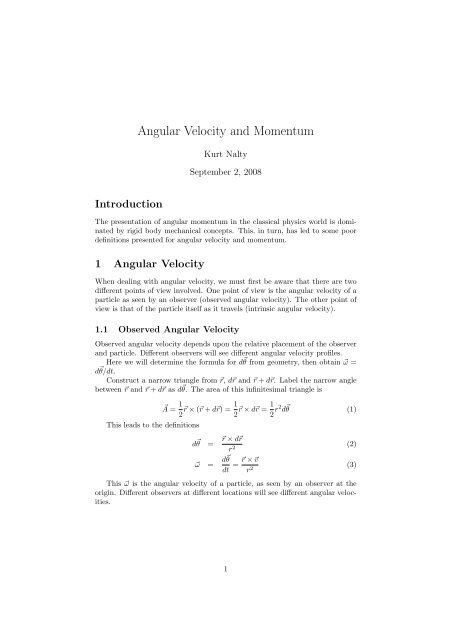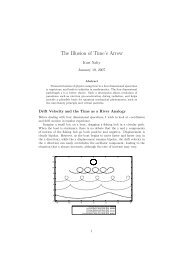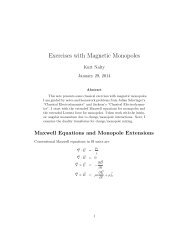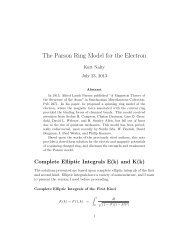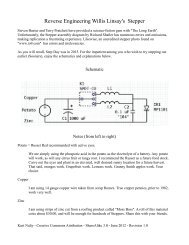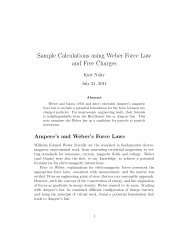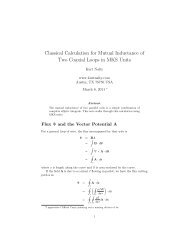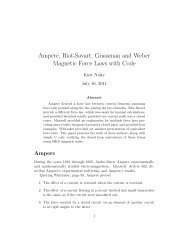Angular Velocity and Momentum - Kurt Nalty
Angular Velocity and Momentum - Kurt Nalty
Angular Velocity and Momentum - Kurt Nalty
You also want an ePaper? Increase the reach of your titles
YUMPU automatically turns print PDFs into web optimized ePapers that Google loves.
<strong>Angular</strong> <strong>Velocity</strong> <strong>and</strong> <strong>Momentum</strong><br />
<strong>Kurt</strong> <strong>Nalty</strong><br />
September 2, 2008<br />
Introduction<br />
The presentation of angular momentum in the classical physics world is dominated<br />
by rigid body mechanical concepts. This, in turn, has led to some poor<br />
definitions presented for angular velocity <strong>and</strong> momentum.<br />
1 <strong>Angular</strong> <strong>Velocity</strong><br />
When dealing with angular velocity, we must first be aware that there are two<br />
different points of view involved. One point of view is the angular velocity of a<br />
particle as seen by an observer (observed angular velocity). The other point of<br />
view is that of the particle itself as it travels (intrinsic angular velocity).<br />
1.1 Observed <strong>Angular</strong> <strong>Velocity</strong><br />
Observed angular velocity depends upon the relative placement of the observer<br />
<strong>and</strong> particle. Different observers will see different angular velocity profiles.<br />
Here we will determine the formula for d ⃗ θ from geometry, then obtain ⃗ω =<br />
d ⃗ θ/dt.<br />
Construct a narrow triangle from ⃗r, d⃗r <strong>and</strong> ⃗r + d⃗r. Label the narrow angle<br />
between ⃗r <strong>and</strong> ⃗r + d⃗r as d ⃗ θ. The area of this infinitesimal triangle is<br />
This leads to the definitions<br />
⃗A = 1 2 ⃗r × (⃗r + d⃗r) = 1 2 ⃗r × d⃗r = 1 2 r2 d ⃗ θ (1)<br />
d ⃗ θ =<br />
⃗ω = d⃗ θ<br />
dt<br />
⃗r × d⃗r<br />
r 2 (2)<br />
=<br />
⃗r × ⃗v<br />
r 2 (3)<br />
This ⃗ω is the angular velocity of a particle, as seen by an observer at the<br />
origin. Different observers at different locations will see different angular velocities.<br />
1
1.2 Intrinsic <strong>Angular</strong> <strong>Velocity</strong><br />
I start by returning to the Frenet formulas. Curvature is the inverse of the<br />
radius of the circle, whose curvature matches the curvature of the trajectory at<br />
that tangent. When people are referring to a radius when discussing the angular<br />
velocity of a particle, it is really the radius of curvature (⃗r = ⃗n/κ) to which they<br />
are referring.<br />
Given that the tangent (along ⃗v), normal (along ⃗r) <strong>and</strong> binormal (along<br />
⃗ω) form an orthogonal triad, we can rewrite the particle velocity <strong>and</strong> angular<br />
velocity equation as<br />
⃗v = ⃗ω × ⃗r → ⃗ω = 1 d⃗u<br />
⃗n × ⃗v = κ⃗n × ⃗v = × ⃗v (4)<br />
r ds<br />
There are a few interesting forms for this formula.<br />
⃗ω = d⃗u × ⃗v<br />
ds<br />
(5)<br />
dθ<br />
⃗ = d⃗u<br />
dt ds × d⃗r<br />
dt<br />
(6)<br />
dθ ⃗ = d⃗u × d⃗r<br />
ds<br />
(7)<br />
dθ<br />
⃗ = d⃗u<br />
ds ds × d⃗r<br />
ds<br />
(8)<br />
d ⃗ θ<br />
ds<br />
Let’s write some expressions for ⃗ω.<br />
= d⃗u × ⃗u (9)<br />
ds<br />
⃗ω = d⃗u × ⃗v (10)<br />
ds<br />
= κ⃗n × ⃗v (11)<br />
[ ]<br />
⃗v × (⃗a × ⃗v)<br />
=<br />
v 4 × ⃗v (12)<br />
[ ⃗av 2 ]<br />
− (⃗v · ⃗a)⃗v<br />
=<br />
v 4 × ⃗v (13)<br />
=<br />
⃗a × ⃗v<br />
v 2 (14)<br />
Now let’s check for ⃗ω × ⃗r = ⃗v, where ⃗r is the radius of curvature.<br />
⃗ω × ⃗r =<br />
( ) ⃗a × ⃗v<br />
v 2 × v2 (⃗v × (⃗a × ⃗v))<br />
|⃗a × ⃗v| 2 (15)<br />
=<br />
(⃗v × (⃗a × ⃗v))<br />
(⃗a × ⃗v) ×<br />
|⃗a × ⃗v| 2 (16)<br />
=<br />
⃗v (⃗a × ⃗v) · (⃗a × ⃗v) − (⃗a × ⃗v) (⃗v · (⃗a × ⃗v))<br />
|⃗a × ⃗v| 2 (17)<br />
=<br />
⃗v (⃗a × ⃗v) · (⃗a × ⃗v)<br />
|⃗a × ⃗v| 2 (18)<br />
= ⃗v (19)<br />
2
Summarizing, we have two different angular velocities involved in the discussion<br />
of trajectories.<br />
One is the angular velocity of a particle on a trajectory as seen by an observer.<br />
In three dimensions, this is given by ⃗ω = ⃗r × ⃗v/r 2 .<br />
The other is the intrinsic angular velocity of the particle as experienced by<br />
itself, due to the curvature of its trajectory. In three dimensions, this is given<br />
by ⃗ω = ⃗a × ⃗v/v 2 .<br />
1.3 Quaternion <strong>Angular</strong> <strong>Velocity</strong> in Fourspace<br />
In four dimensional space, rotation is more complex, as we have more planes<br />
capable of supporting simultaneous rotation. Quaternion multiplication by a<br />
unit vector results in coupled rotations, one about the space vector axis (axis<br />
of rotation parallel with space, normal to plane), the other in the plane defined<br />
by time <strong>and</strong> the space vector (axis perpendicular to space vector <strong>and</strong> time).<br />
Begin by looking at the expressions for three dimensional angular velocity<br />
with respect to path length.<br />
dθ<br />
⃗<br />
ds = d⃗u × ⃗u = κ⃗n × ⃗u (20)<br />
ds<br />
We see that the magnitude of dθ/ds is κ, while the direction is given by<br />
⃗n × ⃗u.<br />
Extending the same process to quaternion space, we have<br />
d˜θ<br />
ds<br />
= dũ<br />
ds ũ (21)<br />
= κñũ (22)<br />
= κũ⃗gũ (23)<br />
( )<br />
⃗a + ⃗a × ⃗v<br />
= κũ<br />
ũ (24)<br />
|⃗a + ⃗a × ⃗v|<br />
( )<br />
|⃗a + ⃗a × ⃗v| ⃗a + ⃗a × ⃗v<br />
=<br />
(1 + v 2 ) ũ<br />
ũ (25)<br />
3/2 |⃗a + ⃗a × ⃗v|<br />
[ ]<br />
⃗a + ⃗a × ⃗v<br />
= ũ<br />
ũ (26)<br />
(1 + v 2 ) 3/2<br />
While not yet terribly insightful, the expression for the angular velocity per<br />
unit distance in quaternion space is<br />
d˜θ<br />
ds = −2(⃗v · ⃗a) (1 + ⃗v) + (⃗a + ⃗a × ⃗v) ( 1 + v 2)<br />
(27)<br />
(1 + v 2 ) 5/2<br />
The angular velocity per unit time is<br />
d˜θ<br />
dt<br />
d˜θ<br />
dt<br />
= −2(⃗v · ⃗a) (1 + ⃗v) + (⃗a + ⃗a × ⃗v) ( 1 + v 2)<br />
(1 + v 2 ) 2 (28)<br />
=<br />
−2(⃗v · ⃗a) (1 + ⃗v) (⃗a + ⃗a × ⃗v)<br />
(1 + v 2 ) 2 +<br />
(1 + v 2 )<br />
(29)<br />
3
The magnitude of the angular velocity per unit time is<br />
|˜ω| =<br />
|⃗a + ⃗a × ⃗v|<br />
1 + v 2 (30)<br />
Finally, note that angular velocity has the same units as energy <strong>and</strong> momentum.<br />
2 <strong>Angular</strong> <strong>Momentum</strong><br />
Classically, the angular momentum of a body is defined by<br />
⃗L = ⃗r × (m⃗v) = ⃗r × ⃗p (31)<br />
where L ⃗ is the angular momentum, m is the mass, ⃗v is the velocity, <strong>and</strong> ⃗r is<br />
the vector from the origin (usually at the axis of rotation) to the particle. The<br />
term ⃗p represents the linear momentum of the particle.<br />
I don’t want to get bogged down by speculating about mass yet, so I’ll leave<br />
m alone for the moment. Likewise, from the previous discussion of intrinsic<br />
angular velocity, I identified r as the radius of curvature r = 1/κ.<br />
The time rate of change of angular momentum is torque.<br />
⃗T = d⃗ L<br />
dt = ⃗r × (m⃗a) = ⃗r × ⃗ f (32)<br />
where ⃗ f is the force on the particle.<br />
More interesting, the curl of classical angular momentum is proportional to<br />
linear momentum.<br />
⃗∇ × ⃗ L = −2m⃗v = −2⃗p (33)<br />
When two equal opposing forces separated by a distance are applied to an<br />
object, we have a torque due to this couple.<br />
⃗T = (⃗r 1 − ⃗r 2 ) × ⃗ f (34)<br />
If we substitute the radius of curvature in the definition of ⃗ L, we obtain the<br />
rather strange looking equation<br />
This can be recognized as<br />
⃗r = 1 κ ⃗n = v2 (⃗v × (⃗a × ⃗v))<br />
|⃗a × ⃗v| 2 (35)<br />
⃗L = mv4 (⃗a × ⃗v)<br />
|⃗a × ⃗v| 2 (36)<br />
⃗L = m 1 ⃗ω<br />
κ2 (37)<br />
= m⃗r × (⃗r × ⃗ω) (38)<br />
= m⃗r × ⃗v (39)<br />
4
3 Action <strong>and</strong> the Quaternion Derivative<br />
Action is lightly addressed in most introductory texts. When used, action is<br />
presented as part of an integral of energy over time in the context of deriving the<br />
Hamilton/Lagrange equations. I believe that action is more fundamental than<br />
currently credited. I also believe that some confusion is possible over whether<br />
energy is a partial or whole derivative of action versus time. I further believe<br />
that action is part of a four-vector, whose spatial components are fundamental<br />
to angular velocity <strong>and</strong> momentum.<br />
Some interesting possibilities to consider are<br />
E = da<br />
dt<br />
? (40)<br />
E = ∂a<br />
∂t<br />
? (41)<br />
(a, L) ⃗ → (E, ⃗p) → (P, F ⃗ ) ? (42)<br />
4 Quantum L Operator Miscellaneous Note<br />
The operator ⃗r × ∇ ⃗ when applied to itself remains a first order operator.<br />
(<br />
⃗r × ∇ ⃗ ) (<br />
× ⃗r × ∇ ⃗ ) (<br />
= − ⃗r × ∇ ⃗ )<br />
(43)<br />
5


